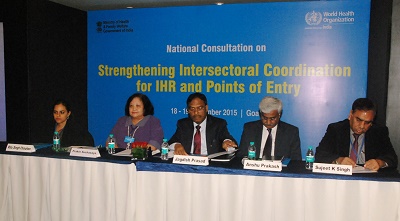
The Ministry of Health & Family Welfare, Government of India signaled its strong commitment to becoming International Health Regulations (IHR) compliant by 2016 at a ‘National consultation on strengthening intersectoral coordination for IHR (2005) and points of entry’ organized in collaboration with the WHO Country Office for India at Goa on 18-19 November 2015.
Speaking on the occasion, Dr (Prof) Jagdish Prasad, Director General of Health Services, Government of India highlighted the critical role various sectors play in IHR and called for greater attention on building capacities at state level, particularly for hospital preparedness, infection control and surge capacity for IHR.
The consultation brought together a number of sectors for enhanced cooperation during public health emergencies, including: human health, animal health, food safety, points of entry (ports, airports and ground crossings), atomic energy, shipping, airport authority, disaster management and response (NDMA), emergency medical and relief, international health as well as the Armed Forces-Health Division.
In his address, Shri Anshu Prakash, Joint Secretary, Ministry of Health & Family Welfare, Government of India emphasized that pathogens do not recognize political boundaries and hence move across countries.
“IHR are an instrument for the world to have a robust protocol for prevention, reporting, information sharing and preparedness,” he added.
Speaking at the consultation, Dr Prakin Suchaxaya, Coordinator-Health Programmes, WHO Country Office for India said, “Building and maintaining IHR core capacities of surveillance, response, laboratory verification, with preparedness, both at national and sub-national level for all hazards, and in particular zoonoses is absolutely critical. This calls for many different agencies and sectors to come together for public health and cannot be done by the health sector alone.”
Apart from the major sectors represented in the meeting, several technical and research agencies also participated, such as the National Centre for Disease Control, National Institute of Virology, Bhabha Atomic Research Centre and the Public Health Foundation of India.
